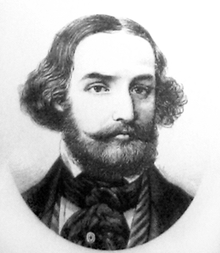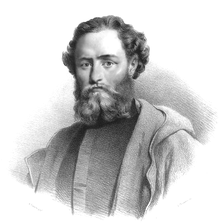Ludwik Mierosławski
Ludwik Mierosławski (born January 17, 1814 in Nemours , France , † November 22, 1878 in Paris , France) was a Polish revolutionary who was involved in numerous uprisings, especially in Poland , but also in Italy . During the Baden Revolution in 1849 he was active as commander-in-chief of the revolutionary army in the fighting to defend a Baden republic as part of the imperial constitution campaign.
Life
Mierosławski was born in France to the Frenchwoman Camille Notté de Vaupleux and the emigrated Polish officer Adam-Gaspard Mierosławski. The Napoleonic general Louis-Nicolas Davout was his godfather . From 1820 he lived in the Russian part of Poland ( Congress Poland ). At the age of 16 he was an ensign in the November uprising against Russia in 1830 . After his defeat, he emigrated back to France in 1831. In 1835/36 Mierosławski published several poems, which, however, met with little approval. In 1842 Mierosławski was elected a member of the Central Committee of Polish Emigrants in Paris.
In 1846 Mierosławski was the leader of a planned all-Polish uprising in the Grand Duchy of Poznan against Prussian supremacy. In the same year he was arrested as a ringleader and sentenced to death in the Poland trial in Berlin in 1847 . Due to his appearance in the process, he received a wide range of support. B. by Bettina von Arnim .
In the course of the March Revolution of 1848 in Prussia , he was first pardoned to life imprisonment, then freed with other captured Polish revolutionaries, and in April / May 1848 led the Polish uprising in Posen to liberate and unify Poland. This uprising, in which Mierosławski also aimed to bring the revolution to the Russian part of Poland, meant for King Frederick William IV the danger of war with Russia . The uprising was suppressed by Prussian troops in May 1848. Mierosławski was captured again. On diplomatic intervention by revolutionary France in the wake of the February Revolution in 1848 , he was again pardoned and expelled to France.
At the beginning of 1849 Mierosławski went to Sicily , where he commanded the revolutionaries there who were also striving for unification of Italy . There, too, his troops were subject to the superiority of the counter-revolution. Wounded in battle, he returned to Paris to recover.
In June 1849 he was called by the provisional republican revolutionary government in Baden to act as general and commander-in-chief with the Baden revolutionary army to defend the Baden revolution against the advancing counter-revolutionary troops under Prussian leadership, after the first commander of the Baden revolutionary army, Franz Sigel , was wounded failed.
Mierosławski showed considerable tactical skill. He succeeded in stopping the attack of the anti-revolutionary intervention army under the leadership of Prince Wilhelm of Prussia, who was notorious as the " Kartätschenprinz ", later the Prussian King Wilhelm I and German Emperor Wilhelm I , in the area between Heidelberg and Mannheim. When the defensive line of the revolutionary troops was bypassed and Prussian troops established themselves in the rear of the Baden after the battle near Waghäusel , Mierosławski led his defeated army in a so-called flank march to the south in order to establish a second line of defense at Rastatt.
But despite Mierosławski's tactical skills, the Baden revolutionaries were unable to withstand the overwhelming odds at Rastatt either. Resigned to the weak political leadership of the Baden revolutionary government as well as to the foreseeable defeat of the poorly armed and trained revolutionary army, he resigned his command on July 1, 1849. Mierosławski retired to Switzerland for three months .
After three weeks of siege, the fortress of Rastatt fell on July 23, 1849. The Baden revolution and with it the revolution of 1848/49 in the states of the German Confederation had finally failed.
After the failed revolution of 1848/49, Mierosławski stayed in Paris again and worked there as a private teacher . In 1861 he was drawn to the struggle for independence again . Giuseppe Garibaldi entrusted him with the supreme command of the international legion in Italy in the repeated struggle against the Austrian supremacy in northern Italy. Until 1862 he was the commander of the Polish military school in Genoa (see also Risorgimento ).
Once again, Mierosławski appeared publicly as the appointed leader (“ dictator ”) in the Polish January uprising of 1863/64 against Russia as a revolutionary . After its suppression, he fled back to Paris.
After that, Ludwik Mierosławski was quiet. He died impoverished on November 22, 1878 at the age of 64 in Paris , where he was buried on the Cimetière Montparnasse .

Although the revolutionary uprisings he led all failed due to the overwhelming power of the enemy, with his reputation as "Polish Napoleon " he is not only an example for the Poles of an unconditional desire for freedom and independence, which always goes hand in hand with his interest in a free Polish nation early internationalism .
Works
- Żelazna Maryna , Paris 1835 (book of poems; Polish) Google digitized version
- Szuja , Paris 1835 (volume of poetry; Polish) digitized from Google
- Bitwa grochowska 1835 digitized
-
Histoire de la révolution de Pologne (Vol. 1–3, Par. 1837; Vol. 4, 1878)
- Volume 1, Paris 1836 in the Internet Archive
- Volume 2, Paris 1836 in the Internet Archive
-
La tache de Caïn (German: Das Kainsmal ), Paris, 1841. under the pseudonym L. Notté de Vaupleux.
- Volume 1 at gallica; French
- Volume 2 at gallica; French
- Critical presentation of the campaign of 1831 and the rules for national wars derived from it. Berlin 1848 Google digitization , in the Internet archive
- Reports on the campaign in Baden (Berlin, 1849) digitized
- Reports of the general Mieroslawski sur la campagne de Bade. Jenni, Bern 1849 digitized; french with a map of military movements
- Deuxième mémoire adressé au gouvernement de SM l'empereur Napoléon III sur l'expédition de Crimée et la conduite de la guerre d'orient. Geneva 1855 in the Internet Archive
- Histoire de la commune polonaise du dixième au dix-huitième siècle. Berlin 1856 in the Internet Archive
- De la nationalité polonaise dans l'équilibre européen. Berlin 1856 in the Internet Archive
- Pamiętnik Mierosławskiego (1861–1863) , 1924, Mieroslawski's diary edited by Józef Frejlich, Polish
literature
- Celina Bobińska: Marx and Engels on Polish Problems . Dietz, Berlin 1958
- Julia Franke (ed.): A European freedom fighter. Ludwik Mierosławski 1814–1878 (= Small Writings of the Association of Friends of the Museum of European Cultures. Issue 5). Berlin 2006, ISBN 3-88609-525-8 .
- Alfred Georg Frey, Kurt Hochstuhl: Pioneers of Democracy. The Baden Revolution 1848/49. The dream of freedom. G. Braun, Karlsruhe 1997, ISBN 3-7650-8168-X .
- Oliver Heyn: A strategic game invented by the Revolutionary General Ludwik Mierosławski (1814–1878). In: Zeitschrift für Heereskunde. Volume 82, number 469, 2018, pp. 130-139.
- Christof Rieber: enthusiasm for Poland in Germany 1848/49? and “Where the revolution is, there is Poland's fatherland.” A Polish commander-in-chief in Baden in 1849: Ludwig Mieroslawski. In: State Center for Political Education Baden-Württemberg (Ed.): "... until it became a free people ..." 1848/49 Revolution (= Germany and Europe. Issue 35). State Center for Political Education Baden-Württemberg, Stuttgart 1997, pp. 6–13.
Web links
- Biographical entry on Mierosławski on rbb-online from the series Deutsche & Polen
- Source material by and about Mierosławski from the Germany and Europe series , published by the State Center for Civic Education Baden-Württemberg, Edition 2/97: 1848/49 Revolution
- A brief background illustration of the liberation of Mierosławski and other Polish prisoners during the March Revolution of 1848 in Berlin
- Speech by the President of the Brandenburg State Parliament in memory of the Polish freedom fighter Ludwik Mieroslawski on March 20, 2007 in Slubice (PDF; 43 kB)
- Mieroslawski, Ludwik. In: Encyclopedia of Revolutions of 1848 at www.ohio.edu; English
- Ludwik Mieroslawski on www.deutscheundpolen.de; accessed on September 13, 2017
- Do broni ludy - Marsz Mierosławskiego battle song from 1848, text by Mierosławski, audio file on www.youtube.com
Individual references / comments
- ↑ s. Pekacz; Books of poetry: Szuja 1835; Żelazna Maryna 1835; Bitwa grochowska 1835; Pugaczow 1836
- ↑ s. Deutsche Zeitung, Heidelberg of August 9, 1847 on the meeting of August 3, 1847 with the appearance of Ludwik Mierosławski, p. 314-315 Google digitized
- ↑ Gustav Julius (Ed.): The Poland Trial. Trial of the 254 Poles who were accused of high treason by the public prosecutor at the Royal Court of Appeal as a party to the enterprise to restore a Polish state within the limits of 1772 (at first instance) in the building of the state prison near Berlin . Berlin 1848, columns 45-65 ( Google digitized version )
- ↑ s. Daniela Fuchs: The great Poland trial in Berlin and Bettina von Arnim's commitment to the accused Mierosławski . In: Julia Franke (ed.): A European freedom fighter. Ludwik Mierosławski 1814–1878 . Association of Friends of the Museum of European Cultures, Berlin 2006
- ^ Deutsche Zeitung, Heidelberg, March 25, 1848, p. 675
- ↑ Outside of the protocol , pnn.de of March 26, 2007, accessed on May 15, 2018
- ↑ his mother was the Frenchwoman Camilla Notté de Vaupleux
| personal data | |
|---|---|
| SURNAME | Mierosławski, Ludwik |
| ALTERNATIVE NAMES | Notté de Vaupleux, Louis (pseudonym); Notté de Vaupleux, L. (pseudonym) |
| BRIEF DESCRIPTION | Polish revolutionary |
| DATE OF BIRTH | January 17, 1814 |
| PLACE OF BIRTH | Nemours |
| DATE OF DEATH | November 22, 1878 |
| Place of death | Paris |

